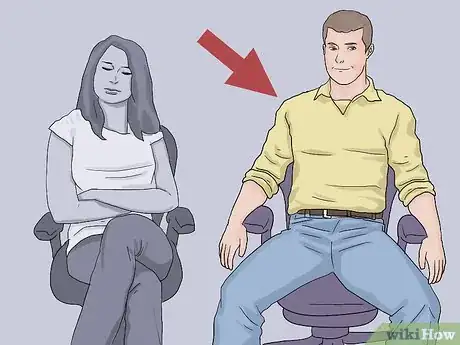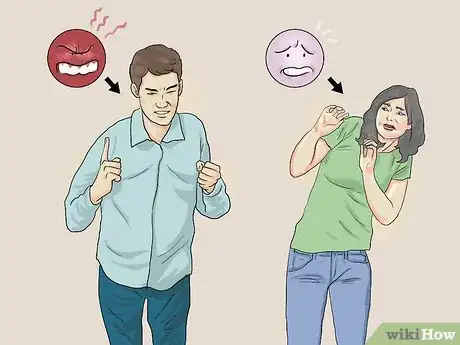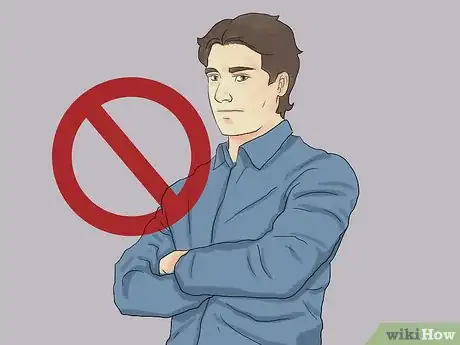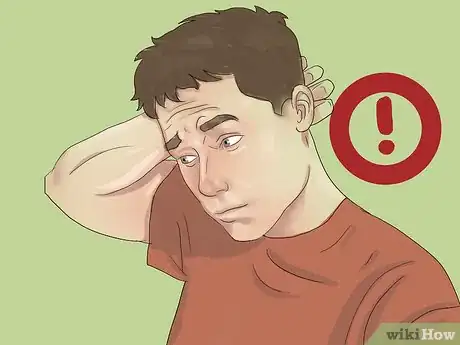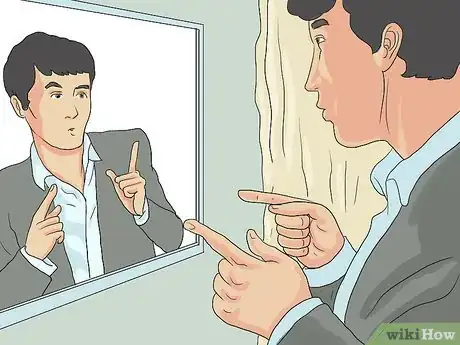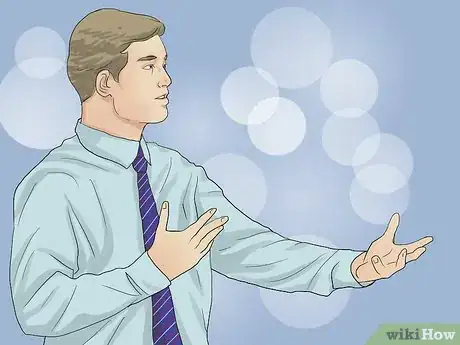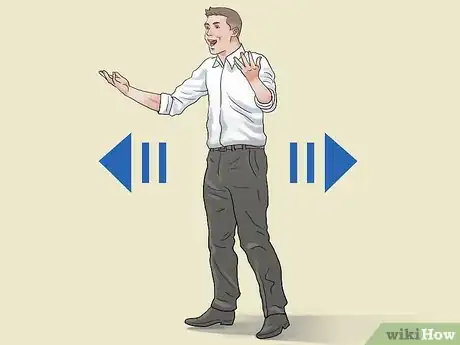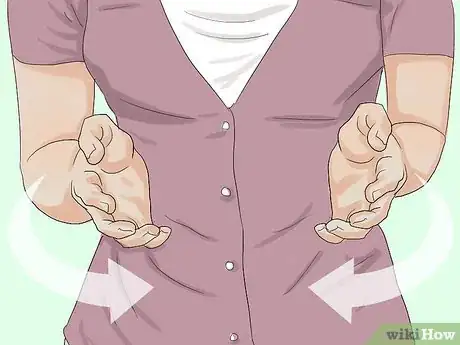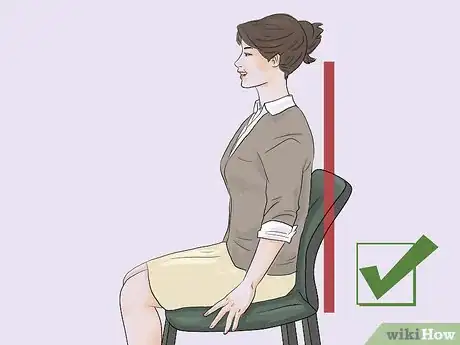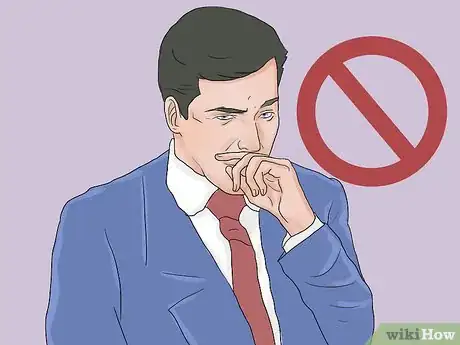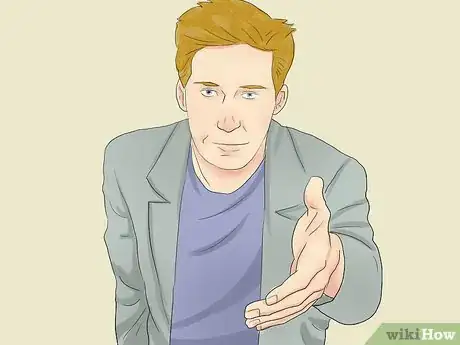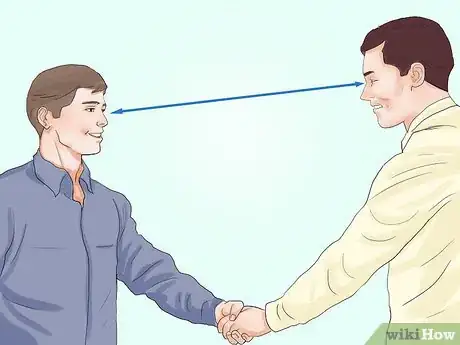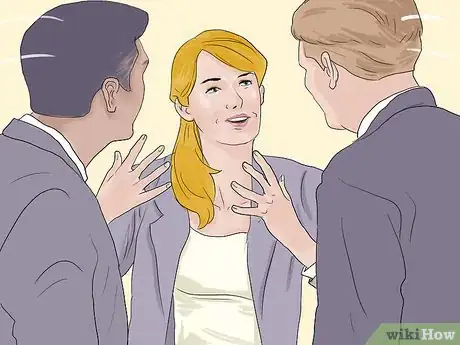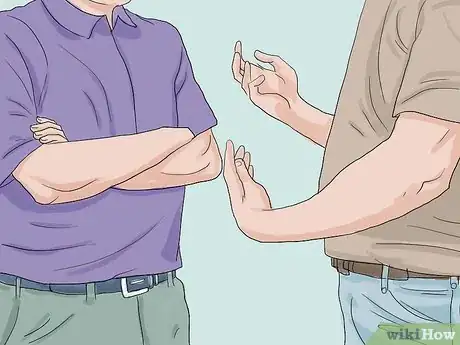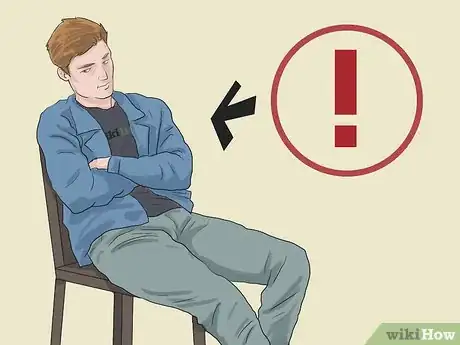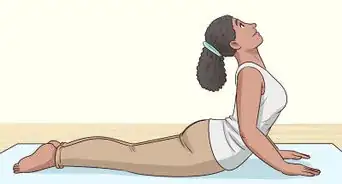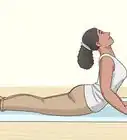This article was co-authored by Dan Klein. Dan Klein is an improvisation expert and coach who teaches at the Stanford University Department of Theater and Performance Studies as well as at Stanford's Graduate School of Business. Dan has been teaching improvisation, creativity, and storytelling to students and organizations around the world for over 20 years. Dan received his BA from Stanford University in 1991.
There are 7 references cited in this article, which can be found at the bottom of the page.
wikiHow marks an article as reader-approved once it receives enough positive feedback. This article received 11 testimonials and 88% of readers who voted found it helpful, earning it our reader-approved status.
This article has been viewed 1,446,680 times.
Body language, sometimes called “non-verbal communication,” is an important tool. The way you communicate through body language can determine your success in everything from relationships to your career. Up to 93 percent of communication can be non-verbal. Paying closer attention to the messages you send through body language can help you succeed.
Steps
Body Language Concepts
-
1Use open body language. This means that you have an assertive handshake, sit calmly, but exude energy, and seem in control of all gestures. [1]
- Your posture should be relaxed, but your back should be straight. This shows people you are comfortable and confident. Pause when you speak to draw in the listener and show confidence.
- Keep your legs slightly apart, so you take up more space. This also demonstrates confidence. Lean in slightly when a person is speaking to show interest (leaning away will show a sense of hostility). [2]
- Don’t cross your arms. Instead, let them dangle at your sides or press them together in your lap. This shows you are open to other people.
- Make sure your handshake is firm, but not too crushing. Look the other person in the eyes, although you shouldn’t stare too much. Blink, and look away sometimes, so they don’t feel you are trying to be intimidating.
- Play with your tone of voice. The tone of voice is a way that people communicate confidence. The key to success is projecting confidence.
-
2Identify emotional body language. You can determine emotions by paying careful attention to non-verbal cues. You should also take into context what’s going on at the time you spot the emotional signs, though.
- When people are angry, their face flushes, they bare their teeth, they clench their fists, and they invade body space, sometimes by leaning forward. [3]
- When people are nervous or anxious, their face pales, their mouth seems dry (so they may drink water or lick their lips), they show varying speech tone, and they have tension in their muscles (so they may clench their arms or hands, and their elbows may be drawn into their sides.) Other signs of nervousness include trembling lip, fidgeting, and gasping or holding breath.
Advertisement -
3Avoid blocking. If you are giving a presentation or speech, you want to be as open as you can to your audience. Thus, you should remove physical barriers that will limit your ability to connect.
- Podiums, computers, chairs, and even a folder are all props that create distance between a speaker and audience, preventing a sense of connection.
- Crossing your arms or speaking to someone while sitting behind a computer monitor are blocking behaviors.
-
4Spot when someone is lying. Body language can give away liars. They might be able to hide their lies in their words, but their bodies often tell another story.
- Liars are less likely to maintain eye contact, and their pupils may appear constricted.
- Turning the body away from you is a sign of lying.
- Complexion changes, such as redness in the neck or face, and perspiration, are all signs of lying, as are vocal changes like clearing of the throat.
- Be aware that some signs of lying – sweating, poor or no eye contact- are also indications of nervousness or fear. [4]
-
5Consider spacing. Different cultures have different ideas about how much physical space you should give another person. But social distance is broken down into four categories.
- Intimate distance. Defined as touching another person to 45 centimeters. If you enter a person’s intimate distance, this can be very unsettling for them unless it’s welcomed or you’re already intimate.
- Personal distance. 45 centimeters to 1.2 m. You are close enough to shake hands and to see each other’s expressions and gestures.
- Social distance. This is the normal distance in situations that are impersonal or business transactions, defined as 1.2 m to 3.6 m. Speech should be louder, and eye contact remains important.
- Public distance. 3.7m to 4.5m. Examples of those who often operate in public distance are teachers or those who talk to people in groups. Non-verbal communication is critical but often exaggerated. Hand gestures and head movements can be more important than facial expressions as the latter are often not perceived.
-
6Identify your body language patterns. Make a conscious effort to think about what your body is doing in different interactions with different people. A mirror can be useful to examine facial expressions and posture, but mainly you just want to pay attention to what your body does when you're angry, nervous, or happy.
- Determine whether your body language is in sync with your message. Your body language is effective if it communicates the message you want it to communicate. Does your posture communicate confidence, or does it make you seem unsure of yourself even though your words express confidence?
- If your non-verbal signals match your words, you'll not only communicate more clearly, you'll also be perceived as being more charismatic.
Gestures
-
1Use hand gestures when speaking. Experts believe that people who are great speakers are more likely to use hand gestures during conversations or presentations, and they say hand gestures give listeners greater confidence in the speaker.
- More complex gestures involving two hands above the waist are associated with complex thinking.
- Politicians like Bill Clinton, Barack Obama, Colin Powell, and Tony Blair are considered charismatic, effective speakers, and that's partly because they frequently use hand gestures.
-
2Move throughout the room. Don’t only move your hands. Great speakers move around. They point at slides, and they don’t keep their distance from people. They are animated.
- Keeping your hands in your pockets when speaking or having a conversation will make you seem insecure and closed off.
- In contrast, if you take your hands out of your pockets and keep your palms upward, you will demonstrate that you are likable and believable.
-
3Spot emblems. These are gestures that are the equivalents of words. Emblems can be either passive or they can be accepting. Remember that some emblems will have different meanings to different cultures.
- Clenched fists or other tension in the body can be signs of aggression, as if the person is prepared for a fight. Facing the other person, squared off and towards them, and sitting near them can also be signs of aggression. Sudden movements might be made.
- In contrast, accepting gestures are those when the arms are rounded and palms sideways, as if the person is offering up a mock hug. Gestures are slow and gentle. Nodding when a person speaks shows you agree with them, and makes you seem like a great listener. [5]
-
4Have good posture. If you go to, say a job interview, and you have bad posture, you will probably register more poorly to the interviewer.
- People will associate bad posture with weak confidence or boredom or lack of engagement. They might even think you’re lazy and unmotivated if you don’t sit up straight.
- To have good posture, your head should be up and your back should be straight. Lean forward if you’re seated. Sit down the front of your chair, and lean forward slightly to show you’re interested and engaged.
-
5Mirror another person. Mirroring is when one partner mirrors the posture of the other partner. By copying the actions of the other person, you will make them feel connected to you.
- You can mirror a person’s tone, body language or position of the body. You shouldn’t do this blatantly or repeatedly though, only subtly.
- Mirroring is one of the most effective ways to use body language to build a rapport with someone. [6]
-
6Emphasize your point with gestures. Have more than one gesture. This will help you better get your message across. If you want to make sure you're not misunderstood, repeat both gestures when you speak the idea aloud.
- If the listener doesn't pick up on one gesture, he or she will likely be familiar with the other. You don't have to use a body language gesture (or two) for every word, but it's a good idea to have a toolbox of gestures you can use to reinforce very important, yet easily misinterpreted concepts.
- Direct the most positive gestures toward the listener. This lets you more clearly indicate that you are offering a favorable outcome to the listener. Direct the most negative gestures away from yourself and the listener. This way you clearly indicate that you wish that no obstacle stands in the way of your intended message.
-
7Avoid gestures that show nervousness or insecurity. Keep a check on other body language signals. Watch for wandering eyes, hands picking at fluff on your clothing and constant sniffling.
- Touching one's face signals anxiety. Improve your posture. If you're constantly hunched over or touching your face, you'll never look confident, approachable or at ease. Improving your posture and working to eliminate nervous tics can be difficult and will take time, but you'll quickly improve your overall non-verbal communication.
- These small gestures add up and are all guaranteed to dampen the effectiveness of your message. Don't worry about if you accidentally perform a few of these in any given setting.
Facial Expressions
-
1Figure out the “visual dominance ratio.” When you are talking to someone, you should try to be the person who is “visually dominant” to demonstrate confidence. This ratio is determined by figuring out who is looking at the other person’s eyes more, and who is looking away more.
- Your visual dominance ratio helps determine where you stand on social dominance hierarchy compared to the other person in the conversation. People who spend most of the time looking away have a relatively low amount of social dominance. People who are less likely to look away are probably the boss. [7]
- People who look downward display helplessness because they seem like they are trying to avoid criticism or any conflict.
-
2Use eye contact to send messages. The eyes are the windows to the soul, as the cliché goes. You can learn a lot about a person by paying attention to how they use their eyes.
- Avoiding eye contact at all, or looking downward with the eyes a lot, are both indications of defensiveness. Eye contact will be more continuous if a person is trying to listen to you, rather than speak. Looking away from the other person can also be an indication the person doing the speaking isn’t ready to stop and listen yet.
- Looking at a person can be an indication of attraction. People who are interested in someone show strong eye contact and lean forward toward the other person in the conversation.
- Depending on the context, making eye contact with another person can be used to show respect. For example, when you’re giving a presentation to a room full of people, divide the room into thirds. Address comments to one side, and then the other side, and then the middle. Pick out a person in each section to address comments to. The people who are sitting around them will think you are having direct contact with them, and this will make them rate you higher as a speaker.
-
3Understand affect displays. Pay close attention to facial expressions that convey emotion, especially if they conflict with the words a person is uttering. They can help you figure out a person’s true emotions.
- Regulators are facial expressions that provide feedback during conversations, such as nodding the head, and expressions of interest or boredom. Regulators allow the other person to assess level of interest or agreement. Essentially, they provide feedback. [8]
- You can show empathy towards another person by using affirmative movements, such as nodding your head and smiling. These gestures, used when another person is speaking, give them positive reinforcement and show you like what they are saying.
-
4Avoid defensiveness. Certain body language gestures, including facial expressions, communicate defensiveness, not confidence. Thus, they make you seem less in control.
- Limited facial expressions and small, close to the body hand/arm gestures are indications of defensiveness.
- Turning the body away from the other person or crossing your arms in front of your body are other indications of defensiveness. [9]
-
5Watch for disengagement. If you are giving a presentation, you want people to be engaged. If you are the person watching the presentation, you want to seem engaged. There are signs you can look for that indicate engagement or a lack thereof.
- Heads tilted downward and eyes gazing elsewhere indicate disengagement.
- Slumping in a chair is a sign of disengagement. Similarly, fiddling, doodling, or writing, are signs that a person is disengaged.
Expert Q&A
-
QuestionHow can I improve my body language and communication skills?
 Dan KleinDan Klein is an improvisation expert and coach who teaches at the Stanford University Department of Theater and Performance Studies as well as at Stanford's Graduate School of Business. Dan has been teaching improvisation, creativity, and storytelling to students and organizations around the world for over 20 years. Dan received his BA from Stanford University in 1991.
Dan KleinDan Klein is an improvisation expert and coach who teaches at the Stanford University Department of Theater and Performance Studies as well as at Stanford's Graduate School of Business. Dan has been teaching improvisation, creativity, and storytelling to students and organizations around the world for over 20 years. Dan received his BA from Stanford University in 1991.
Improvisation Coach Align your gestures with your words and intentions. If your gestures don't match the words that you're saying, people listening to you will sense that something is wrong.
Align your gestures with your words and intentions. If your gestures don't match the words that you're saying, people listening to you will sense that something is wrong. -
QuestionHow should I act towards a boy who is avoiding my love?
 Community AnswerWatch his nonverbal communication. If he does not watch you or glance at you, he has no interest.
Community AnswerWatch his nonverbal communication. If he does not watch you or glance at you, he has no interest. -
QuestionI want to know the correct facial and body language gestures which should be helpful to give a great impression.
 Community AnswerSmile, be confident, and stand up straight. These simple gestures are highly effective.
Community AnswerSmile, be confident, and stand up straight. These simple gestures are highly effective.
Warnings
- Not everyone uses the same gestures to convey the same meaning. For example, in the U.S. feet spread apart typically conveys the message you are standing your ground. In Japan, your feet would typically be together, with the hands directly at the sides to convey this meaning.⧼thumbs_response⧽
- Faking a gesture or facial feature to convey a meaning is the same as lying and can be interpreted this way. When people say that someone seems phony, they are usually referring to mannerisms that seem fake.⧼thumbs_response⧽
- Understand that people are liable to misinterpret your body language. Always try to be clear and try to reinforce your meaning.⧼thumbs_response⧽
- Do not assume that you have correctly identified the meaning of another person's body language without verification. Context matters too. For example, people often interpret a person's arms crossed across their chest as meaning that they are distancing or displaying a defensive character. Perhaps they are simply cold!⧼thumbs_response⧽
References
- ↑ http://www.forbes.com/sites/keldjensen/2012/06/12/the-naked-truth-how-body-language-reveals-the-real-you/
- ↑ https://blog.udemy.com/positive-body-language/
- ↑ http://changingminds.org/techniques/body/emotional_body.htm
- ↑ http://www.forbes.com/sites/keldjensen/2012/06/12/the-naked-truth-how-body-language-reveals-the-real-you/
- ↑ http://elitedaily.com/life/culture/5-secrets-improving-communicate-body-language/1066180/
- ↑ http://elitedaily.com/life/culture/5-secrets-improving-communicate-body-language/1066180/
- ↑ https://www.psychologytoday.com/blog/subliminal/201205/how-we-communicate-through-body-language
- ↑ http://www.skillsyouneed.com/ips/nonverbal-communication.html
- ↑ http://www.mindtools.com/pages/article/Body_Language.htm
About This Article
To communicate with body language, try using hand gestures during conversations or presentations to show confidence. You should also keep your posture relaxed and avoid crossing your arms, which can make you look defensive. Additionally, look people in the eye, but blink and look away every once in a while so you don’t come off as intimidating. If you want to make someone feel more connected to you, subtly mirror their gestures and body position, which will help build rapport and trust. For advice on how to interpret other people’s facial expressions, keep reading!
